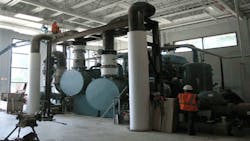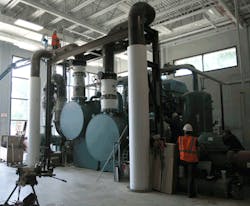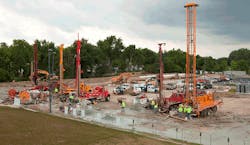Ball State University’s geothermal system will be largest in U.S.
The project began with a groundbreaking ceremony on May 9, 2009, and the first phase of the conversion process, roughly one-half of the campus is now in operation, which includes 19 buildings, representing 50% of the campus. The remaining 27 buildings will be connected to the geothermal system during Phase 2 of the project. All the buildings on the 730 acre campus total 6,700,000-sq.ft., which will be heated and cooled via the system.
Related Articles:
Geothermal to the rescue
Related Articles:
Michigan’s largest geothermal system cuts HVAC costs by 35%
Jim Lowe, director of engineering, construction, and operations at Ball State University has been managing this impressive project since the first day.
“Phase 1 of the geothermal conversion is complete,” said Lowe. “This half of the project was completed in two years with multiple contractors working simultaneously.
“The University had originally decided to replace four stoker coal-fired boilers with a Circulating Fluidized Bed boiler,” added Lowe. “The cost of the project escalated to a level that forced us to consider other options. Geothermal was evaluated as an option to burning a fossil fuel. After a ‘proof of concept’ validated the approach the decision was made to install a geothermal ground source heat pump system that would provide both hot water and chilled water.”
Lowe believes this is a major paradigm shift from burning a fossil fuel to the use of a renewable energy source. Ball State University will reduce its carbon footprint by nearly 75,000 tons and save an estimated $2 million a year in energy costs once the entire conversion is complete.
“The project takes geothermal and applies it in a new and exciting way,” said Michael Luster P.E., LEED AP, senior mechanical engineer at MEP Associates, Rochester, Minn., the engineering and consulting firm for the project. “Geothermal for an individual building application has been around for quite some time, but applying it at a campus level is taking it to the next step and opens some new opportunities to save energy and reduce carbon emissions.”
Phase 1 design
The design for Phase 1 was divided into many different construction packages, which allowed for construction to start on certain areas of the project while the design continued for other areas. MEP Associates was the prime design firm for eleven construction packages (eleven separate contracts) for Phase 1. The firm also contributed to eight other construction packages on campus.
“The design team implemented a phased approach that turned over the north half of campus and then moved south,” said Luster. “That allows the existing chill plant and heating plant located in the south to remain in operation until the project is complete.”
After Phase 1 and Phase 2 are complete the University will have two District Energy Stations: the District Energy Station North, a new building on the north campus, and the District Energy Station South, located on south campus in the chiller plant, which will be renovated and square footage added to the building. The original heating plant will remain in operation and the gas fired boilers will provide steam to the hospital that is located on the south of campus.
According to Luster, some of the challenges faced during the design of Phase 1 were the size and complexity of the project.
Equipment selection was also a challenge.
"Certain equipment has limitation as too what is capable of doing (i.e., how hot of water can different heat pump chillers produce),” said Luster. “Every building on campus was analyzed and the effects of different temperature of hot water was evaluated. 150°F was determined to provide the best balance between costs to replace heat transfer equipment in buildings and energy consumption.”
3,600 bore holes
According to Lowe, the first project phase has 1,800 bore holes, and once all the phases of the project are complete, there will be a total of approximately 3,600 bore holes. The geothermal system is a vertical closed-loop system that only uses fresh water.
Companies that drilled the bore holes during Phase 1 include Ortman Drilling/Triton Geothermal, Kokomo, Ind.; Moss Well Drilling, Galveston, Ind.; Dilden Brothers Drilling, Lafayette, Ind.; Dedicated Geothermal, Loretto, Minn.; McKeever Well Drilling, Schroeder, Minn.; and TL Stevens Well Company, Maple Plain, Minn.
Kevin Austin project manager at Ortman Drilling/Triton Geothermal, helped manage both Ortman Drilling and Dedicated Geothermal crews on this project, and both companies hired other companies to help drill all 1,800 bore holes.
“Ortman Drilling created Triton Geothermal with two other Indiana companies: Moss Drilling & Dilden Brothers Drilling,” said Austin. “Triton Geothermal was formed to give these three central Indiana drilling companies more production capability. This synergy tripled the labor and equipment capabilities of any one company and allowed them to be much more competitive on large scale projects such as Ball State. Triton has gone on to complete several other large commercial geothermal projects (from 50 to 450 boreholes).”
“The phase 1 drilling took just under one year to complete,” added Austin. “During the winter months — late December, January and February — the production slowed to a crawl, but that’s typical for this region. Bore holes drilled during Phase 1 were 400-ft. deep, 6-in. in diameter with double 1-in. loops, and Phase 2 bore holes will be 500-ft. deep, 6-in. in diameter, and will have a single 1 ¼-in. loop. The Ball State University project has raised the bar for future large-scale geothermal systems in the Unites States and around the world.”
Matthew J. Thuer, project manager at Greiner Brothers, Indianapolis, the project’s mechanical contractor, oversaw the mechanical installation of the Phase 1 energy station, which included installing two 2,500-ton York chillers, Taco pumps, an expansion tank, and other accessories. The firm also oversaw conversions in a dozen or so campus buildings that had to take place.
“The pumps in the chiller building are pushing 12,000 GPM, which is a huge amount,” said Thuer. “We also installed a 16,000-gal. custom made tank built by Kennedy Tank Mfg. Co., down in the basement, a York air handling unit and Spirotherm air dirt separators.”
Greiner Brothers also worked on upgrading the existing air handling equipment in campus buildings for the new geothermal system.
“We are tying air handling equipment and piping into this new geothermal piping that was just installed,” said Thuer.“So air handling units that took hot and chilled water are now taking this hot and chilled geothermal water. So there were some coil changes, control valve changes, new pumps by Bell and Gossett and heat exchangers installed in these different buildings.”
Prefab piping
“The engineering consulting firm, MEP Associates, Rochester, Minn., had a 3D model already made, and we had to make the piping fit to the exact fittings,” said Thuer. “The footprint of the building was very small, so we couldn’t just use conventional fittings. We had to dial it in because some locations just had a 4-in. plus or minus window, when you are installing 24-in. pipe.”
“We prefabbed 80% of the piping off site, and we were able to do that because of the BIM drawings produced,” said Thuer. “There was a huge time constraint on us too. When we were awarded the project we immediately started prefabbing because we knew we had to get it into the basement before they started the upper floors.”
Thuer said that the biggest challenge was that the project was spread out over a huge area.
“It went across the whole north half of the campus,” said Thuer. “It was more spread out, so you had the challenges of having guys in different buildings all over campus that you had to continually monitor and feed material to and such, so that was a big challenge — that it was spread out.”
There were about 45 pipefitters total working on Phase 1, including the chiller facility and the different buildings on campus, according to Thuer.
Also during Phase 1, the new hot water distribution system was installed under many different contracts. Sater Electric, Daleville, Ind.; 3D Company, Muncie, Ind.; Greiner Brothers, Indianapolis; and JG Case, Muncie, Ind., installed the majority of the system.
“The most challenging part of the project was determining a route for the new hot water distribution system,” said Lowe. “Along with that challenge came the logistical issues with the actual installation.” Regarding Phase 2 of the project, partial drilling of a south well field has been started. The drilling and other related work will continue for perhaps the next two years.
About the Author
Candace Roulo
Candace Roulo, senior editor of CONTRACTOR and graduate of Michigan State University’s College of Communication Arts & Sciences, has 15 years of industry experience in the media and construction industries. She covers a variety of mechanical contracting topics, from sustainable construction practices and policy issues affecting contractors to continuing education for industry professionals and the best business practices that contractors can implement to run successful businesses.


